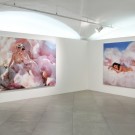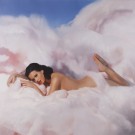Centre for Contemporary Culture at Palazzo Strozzi
Palazzo Strozzi
Will Cotton

Will Cotton creates an unreal world of overabundance in which everything becomes cotton candy, custard and cream, merging references to the American pop culture and art history.
Warning: A non-numeric value encountered in /var/www/vhosts/strozzina.org/httpdocs/admin/wp-content/plugins/lightbox-gallery/lightbox-gallery.php on line 443
- Exhibition view "American Dreamers", CCC Strozzina, Palazzo Strozzi, Firenze
Will Cotton, Various works, Courtesy the artist, Mary Boone Gallery, New York / Galerie Daniel Templon, Paris (foto Martino Margheri)
- Exhibition view "American Dreamers", CCC Strozzina, Palazzo Strozzi, Firenze
Will Cotton, Various works, Courtesy the artist, Mary Boone Gallery, New York / Galerie Daniel Templon, Paris (foto Martino Margheri)
- Exhibition view "American Dreamers", CCC Strozzina, Palazzo Strozzi, Firenze
Will Cotton, Various works, Courtesy the artist, Mary Boone Gallery, New York / Galerie Daniel Templon, Paris (foto Martino Margheri)
- Exhibition view "American Dreamers", CCC Strozzina, Palazzo Strozzi, Firenze
Will Cotton, Various works, Courtesy the artist, Mary Boone Gallery, New York / Galerie Daniel Templon, Paris (foto Martino Margheri)
- Exhibition view "American Dreamers", CCC Strozzina, Palazzo Strozzi, Firenze
Will Cotton in front of his painting.
- Will Cotton
Consuming Folly, 2009-2010 - Olio su lino / Oil on linen - 182,9 x 243,8 cm - Courtesy Collezione privata / Private collection, Galerie Daniel Templon, Paris - Photo: B.Huet/Tutti
- Will Cotton
Cotton Candy Katy, 2010 - Olio su lino / Oil on linen - 182,8 x 213,3 cm - Courtesy Direct Management Group, Los Angeles - Photo courtesy l’artista e / the artist and Mary Boone Gallery, New York
- Will Cotton
The Consummation of Empire, 2008 - Olio su lino / Oil on linen - 213,3 x 142,2 cm - Courtesy l’artista e / the artist and Mary Boone Gallery, New York
- Will Cotton
Abandoned (Churro Cabin), 2002 - Olio su lino / Oil on linen - 152,4 x 152,4 cm - Courtesy l’artista e / the artist and Mary Boone Gallery, New York
Through his art Will Cotton grants the wish of every child across America by creating a world built entirely by candy, directly alluding to the popular board game Candy Land and to movies like Willy Wonka & the Chocolate Factory. His paintings portray figures and landscapes made from an assortment of sweets, from cotton candy to taffy to liquid caramel. Cotton’s works are first developed as miniature models inside his studio and after the model is completed, he uses a realistic technique to paint renderings of the three-dimensional forms.
Cotton expresses a sensibility for mixing high and low art forms through a complex interplay between kitsch and consumerist fantasy. His paintings are often done on a large scale, giving his frivolous subjects the monumentality of history painting. His aesthetic quotes eighteenth-century artists like François Boucher, Jean-Honoré Fragonard and Giambattista Tiepolo. Although he maintains their Rococo aesthetic, he fills his settings with figures from the contemporary world, from the likes of New York City socialites to show-business stars like Katy Perry, an icon in today’s pop music scene. Cotton also created Perry’s Teenage Dream album cover (visualized in the painting Cotton Candy Katy) and the set for her California Gurls video, thus opening a new and wider communication network for his works and inverting the traditional relationship between pop culture and “high” art.
Cotton’s female characters quote traditional iconographic and stylistic elements, while at the same time they become objects of a new form of erotic desire, demonstrating a self-aware and post-feminist exhibitionism that is particularly suited to our age of self-promotion.
In addition to a strong voyeuristic element, the paintings seem to induce in the viewer a reflection on our times, underlining a sense of decadency hidden within the splendour and opulence of the subjects. In addressing the hyper-consumerism of contemporary society, Cotton reflects on the iconography of the Golden Age as the apex of human history that at it’s height was inevitably doomed to fall. In his work, The Consummation of Empire, the artist quotes the famous series by the nineteenth-century American artist Thomas Cole, The Course of Empire, whose response to human nature had already pointed out the unavoidable, dramatic end of American ambition for success and strength. The sunset over the marzipan castle, the fast-approaching shadows in Consuming Folly, the overwhelming sugar doused on the churros in Abandoned along with other elements in Cotton’s work seem to prefigure the implosion and crisis of a civilization made blind and distracted by its excesses.
Will Cotton (1965, Melrose, MA, USA; lives and works in New York) is a painter whose work primarily features landscapes composed of sweets, often inhabited by human subjects. Cotton studied in France at the Fine Arts Academy in Rouen, then he came back to the United States where he finished his studies at the Cooper Union and then at the New York Academy of Art. He is represented by Mary Boone Gallery, New York; Baldwin Gallery, Aspen, CO; Michael Kohn Gallery, Los Angeles; Galerie Daniel Templon, Paris, France and Jablonka Galerie, Cologne, Germany. His works have also been exhibited at the San Francisco Museum of Art (2000); the Seattle Art Museum (2002); the Kunsthalle Bielefeld, Germany (2004); the Hudson River Museum (2007); the Triennale di Milano, Italy (2007); the Musée Marmottan Monet, Paris (2008). His work is in the collections of the Seattle Art Museum, Washington and the Columbus Museum of Art, Ohio, as well as many prominent private collections. His recent exhibitions include: (2009) Talk Dirty to Me, Larissa Goldston Gallery, New York; I Want Candy: The Sweet Stuff in American Art, Fresno Metropolitan Museum, Fresno, CA; Chelsea visits Havana, Museo Nacional De Bellas Artes, Havana, Cuba; Aspects of Pop Art, Galerie Gmurzynska, Zurich, CH; Transitions. Painting at the (Other) End of Art, Collezione Maramotti, Reggio Emilia; A Tribute to Ron Warren, Mary Boone Gallery, New York; (2010) Accessories to an Artwork, Glenn Horowitz Bookseller, East Hampton, NY; Divine Comedy, Sotheby’s, New York; (2011) Tous Cannibales, La Maison Rouge, Paris. Recent solo shows were held at galleries like (2009) Mary Boone Gallery, New York; (2010) Galerie Templon, Paris; Pace Prints Chelsea, New York; Baldwin Gallery, Aspen, CO; (2011) Michael Kohn Gallery, Los Angeles.
« back to exhibition
| M | T | W | T | F | S | S |
|---|---|---|---|---|---|---|
| « Jun | ||||||
| 1 | 2 | 3 | 4 | 5 | 6 | |
| 7 | 8 | 9 | 10 | 11 | 12 | 13 |
| 14 | 15 | 16 | 17 | 18 | 19 | 20 |
| 21 | 22 | 23 | 24 | 25 | 26 | 27 |
| 28 | 29 | 30 | 31 | |||















